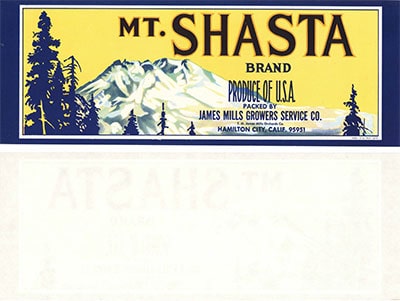Tips on Building your Collection of Vintage Fruit Crate Labels
Collecting labels goes back to when they were first printed. Labels were so colorful with such captivating artwork that people wanted to hold on to them. A good example is an 1890s salmon cannery owner who wanted to design his own custom labels. He went to the lithograph companies in San Francisco, a major hub for lithographers, and looked at some designs to get an idea for his own brand. He ended up putting together a wonderful scrapbook with a couple hundred early can labels; an amazing collection of salmon and fruit can labels which has been placed in theAstoria Maritime museum. It's not common, but there are a few early collections that were primarily put together by people in the industries.
Other than the few industry collectors, organized fruit crate label collecting started in the 1960s. A handful of insightful people began gathering fruit crate labels after they realized the historical, artistic and monetary value they held. Getting the labels wherever they could find them, these people were saving labels from being thrown in the dumpster. From the 1960s to the 1990s, collecting was generally inside the industry and based on location. For example, Washington had a group of apple crate label collectors while Southern California and Florida had citrus label collectors. In the 1990s, the internet and eBay came along which substantially increased the exposure of labels and started up a whole new group of collectors nationwide and allowed collectors to collect outside their immediate communities. Many of the new collectors are more image-based and collect a wide variety of labels.
This question is often thrown around in label collecting communities. The answer is simple: collect what you like. Also remember it’s a hobby, not some kind of retirement investment. In a TV segment on home decorating, the host said you should surround yourself with what makes you happy. That aligns perfectly with how we believe you should be starting your label collection.
That being said, it is good to focus on a main area. For example, some people collect fruit crate or can labels from certain locations, labels with birds on them or scenic images of orchards. Our personal collection is focused on images we like, crate labels and can labels from areas we've lived, or labels with a special meaning due to the people we have gotten them from. This Itoya album has two of our favorite can labels, along with a Mt. Lassen citrus label, since Mt. Lassen is fairly close. Affordability is also an important factor to consider - collecting one of everything can be a major investment
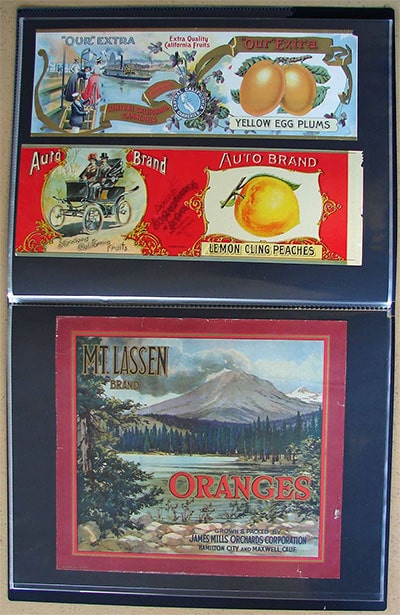
Dwayne, The Label Man, uses albums to store his label collections. Another method is storing large collections in filing cabinets, but there is a high risk of damage from handling. Labels should be stored in a dry areawith acid-free material; moisture and direct sunlight are two of the worst elements which to expose crate and can labels.
Here's a photo of a nine-by-12-inch Itoya art portfolio book with two pear crate labels from our collection. Itoya art portfolios come in a variety of sizes and are very reasonably-priced. You can find them online, or, if you like, contact us and we’ll send you a link. We would recommend the 11-by-14-inch books for odd-shaped strips, can labels, citrus and apple labels.
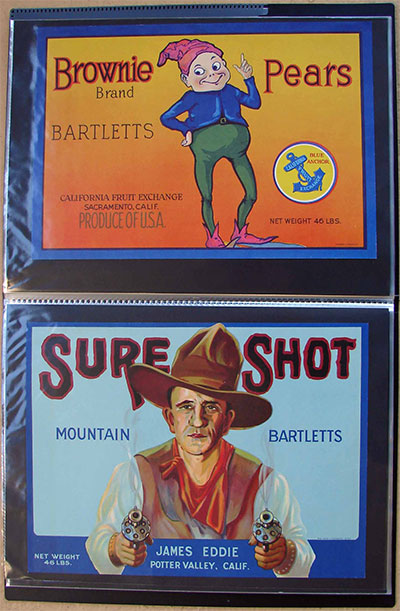
There is no standard grading guideline. Dealers could have multi-point grading systems or simply mention that their labels are “old” or to “expect damage.”
As for our grading, mint labels are perfect, mint to near mint or excellent labels have a very small handling mark or two. Handling marks show up more on labels that are heavily varnished. A varnish was applied at the end of the printing process, giving the label more of a brightness. Any small bend from handling will show up because some collectors are heavy handed. These are minor and won’t show up after framing, and, for the most part, many label dealers don’t even mention them.
Rather than using a general term like good or fair for labels with damage, we will mention any noticeable marks such as border tears, border wear, tears, creases, bends, folds, exposure to moisture, printing flaws, writing, holes and string damage from being wrapped in bundle. On labels with condition issues, we will have a scan of the exact label, so you will be able to see the condition issue and decide for yourself. You can always return something, but, with access to the scans beforehand, we rarely get returns.
The internet is flooded with reproductions and websites selling them. They are often referred to as art prints or crate label art, so you must be careful to read the fine print when looking over a label selection. Collectors generally know the difference, but reproductions are a problem for dealers. In the case of a family member inheriting a collection, they would be disappointed finding no value in reproductions, color copies or art prints. It is good to write reproduction on a back so people will know. Collectors could be offered collections that sounded great only to findsome of the labels were reproductions.
The Label Man does not deal in reproductions since labels are abundant and reasonably priced. There’s something about having the real thing, not only the better quality, but also the idea of holding something 50 to 130 years old. Knowing the area or packaging house it came from and the history behind it just adds to the effect. If it’s a rare label and you can’t find one, or the affordability is a problem, then buying a copy might be your only choice. Often, people will be selling a reproduction of a common label for more than we sell the real one. The best way to know if you were sold a reproduction is to understand a little about how the labels were printed and dating them, which will be covered next.
First, you must realize that you’ll see a lot of variation with labels. These were printed all over the country, from the large lithographers such as Schmidt Litho to smaller regional printers such as newspapers or local print shops. Some were done in many colors, others one or two colors. Some lithographers were more talented than others, and some had better machinery.
This period was an amazing period for early crate and can label art and printing in general. Color print was starting to be mass produced. There are some nice canning labels from this age which are still available at reasonable prices, such as the butterfly series. Most labels from this time have a heavy varnish or near lacquer finish, the paper is extremely brittle and there will be signs of aging on the reverse.
These were printed using limestone or metal (zinc or aluminum) plates. Color was controlled by either hand stippling in the early part of this period to Ben Day screens around 1900. Colors are bright and should be easy to tell from a reproduction. Toward the end of this period, you started to see embossing such as the butterfly kidney bean label in the image.
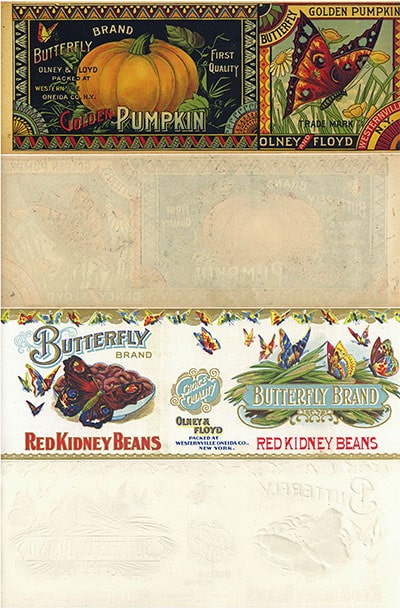
Most labels from this period have the stippled look mentioned above. Toward the end of this time, photo-mechanical techniques were being developed. You’ll want to look for aging on the paper, discoloration on the back edges and the off-colored white of the paper itself.
Some of the labels from this period have a varnish, but not as thick as the older labels. The varnish helped bring out the colors on the label and protects from moisture.
Quite a bit of embossing and gold trim was used on can labels. As above, colors are bright and vivid so labels from this period should be easy to tell from a reproduction. The image shows the front and back of an early Myrtle prune label, also the front of an embossed Griffon brand with gold trim.
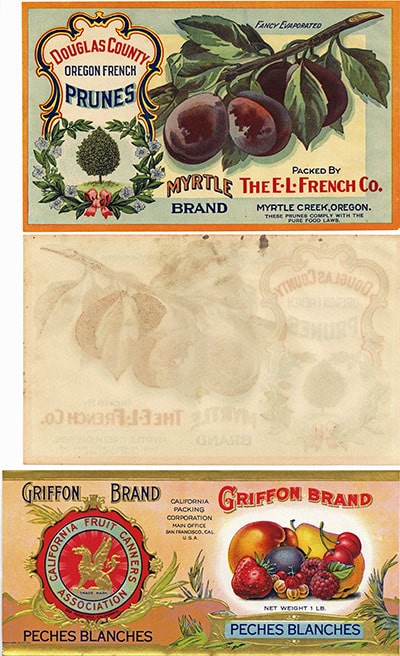
During 1930s to the 1950s, photo-mechanical printing was being used by most printers. The colors were rich, the paper shows some age, mainly at the beginning of this period.
A lighter varnish or finish was used on many labels during this time. You should look for some slight discoloration on the back, test the feel of the paper and check for a slight odor. Colors are bright and vivid yet labels from this period are a little more difficult to determine from a reproduction.
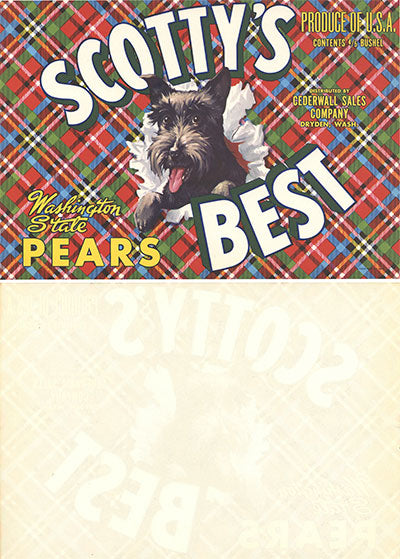
Labels printed from the 1960s to present time are very difficult to tell from a reproduction. Labels from this period are recent and the paper used doesn’t show signs of age. People do still collect these more recent labels and generally the prices are very low.
For labels from this period, and in general, our best advice is to buy from a reputable dealer to avoid reproductions. Keep in mind that by this time you are mainly looking at smaller sized labels and a few pear labels. Oranges and other high production produce had moved to cardboard boxes by now.
